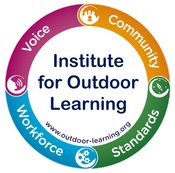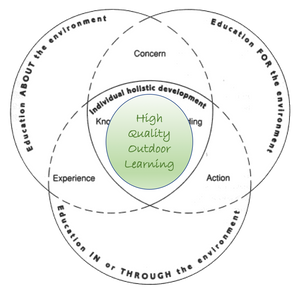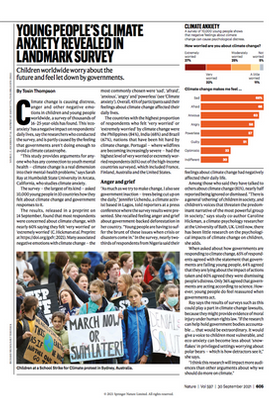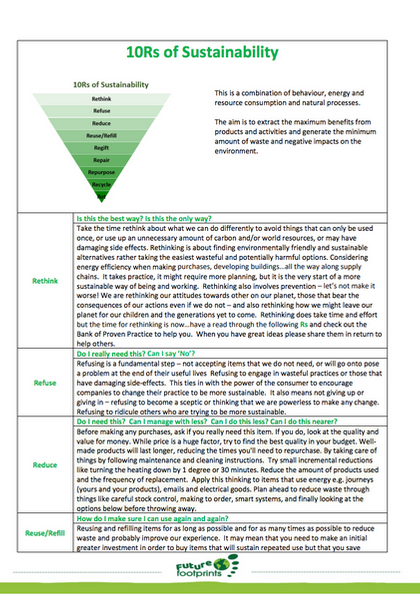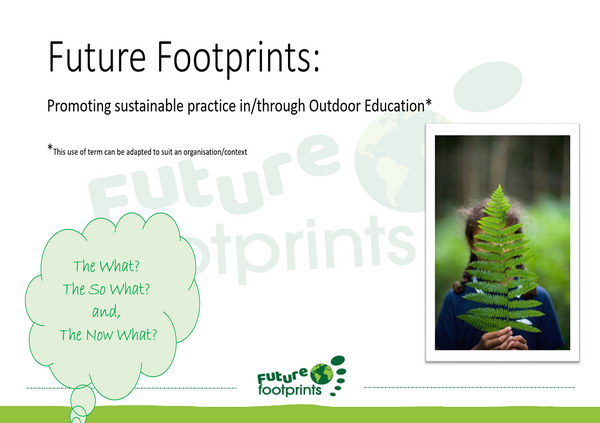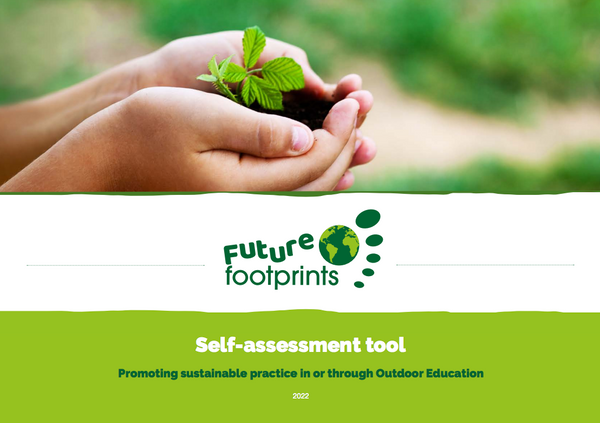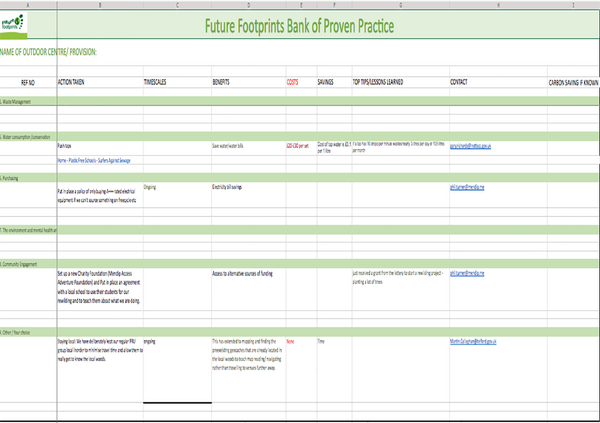Sustainable Practice - Future Footprints
Promoting sustainable practice in/through Outdoor Learning
The goal of Future Footprints is to develop an understanding of, and desire to achieve, a sustainable future environment on our planet through engagement in Outdoor Education
Introduction to Future Footprints
It is now accepted that we are living at a time where we must act urgently to change our existing systems and ways of relating to the planet. This change must be at every level; personal, community, national, and global. We are in the privileged position of being able to introduce children and adults to the beauty and benefits of the outdoors and can reconnect them and instil in them the concept of stewardship of the environment.
There is a lot of fear, despondency, avoidance and ignorance. We know that children and young people are increasingly anxious about the climate and the environment. Studies show distress, anger and other negative mental health problems are increasing in 16 to 25 year olds due to “eco anxiety”. Nature 597, 605 (2021).
We know that the UK is the world’s second worst producer of plastic waste per person, behind only the US. Sadly, despite our best efforts at home and at work, less than 10% of our plastic is actually recycled. Most of it is shipped and dumped. Greenpeace(2021).
We also know the importance of biodiversity and the poor state of the UK’s biodiversity relative to other countries. Biodiversity loss risks 'ecological meltdown' – scientists By Helen Briggs BBC Environment correspondent .
The Future Footprints initiative is a means of ensuring we get our own house in order and have a positive impact through the lives of all those we have contact with. Starting with our actions at home and at work in our immediate environment, we can begin to make changes for the better.
Three core principles support this goal and form the basis for action:
- The necessity to reduce an organisation's environmental footprint in all aspects of its operations and supporting the move towards carbon neutrality
- A desire to establish long term positive behaviour and environmental responsibility in adults and young people through engagement in systematic, effective education
- To encourage the relationship between active environmental engagement and positive mental health and wellbeing

Key Definitions
Sustainability:
Meeting the needs of the current generations without compromising the ability of future generations to meet their needs
Biodiversity:
The variety of all living things on Earth and how they fit together in the web of life bringing Oxygen, water, food and countless other benefits
Carbon Neutral:
Where the carbon emissions caused by human activity are either completely removed or have been balanced out by carbon savings elsewhere
We must look at the whole picture and ask, “Does our way of life harm nature? Does our way of life harm our fellow humans? Do we live at the expense of the present, and at the expense of the future?” If we answer truthfully, we will know how to orientate our lives and our actions… we must learn to live in a way that makes a future possible.

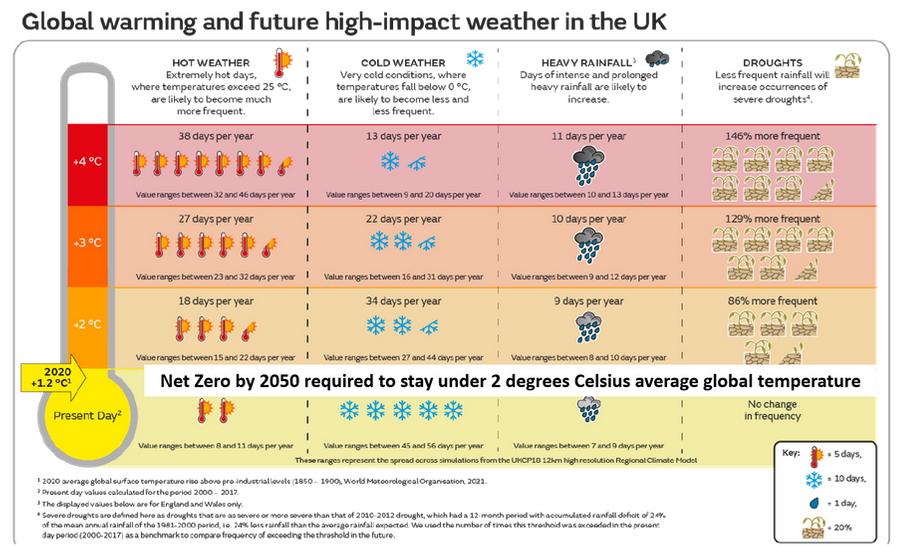
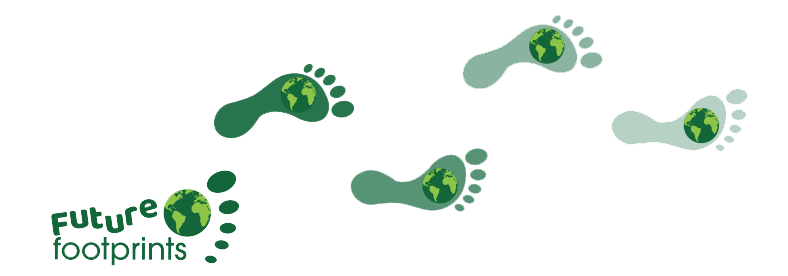

Carbon Calculator
This Carbon Accounting Tool has been produced by Local Partnerships to help local authorities establish their baseline greenhouse gas emissions over a single reporting year. This tool provides a focus on Scope 1 and 2 emissions and is developing some Scope 3 data sets. Please read the “Scope Guidance” sheet carefully to determine which consumption data is to be considered in-scope
Case Studies
Case Studies - Future Footprints Case Study Form
Case Study - Plas Gwynant Outdoor Education Centre
Plas Gwynant became an Eco centre in 2008 and remained so until the scheme came to an end. By this time the ethos and ideas had become so entrenched in the everyday life of the centre that the staff decided on an informal rebrand, incorporating a big green thumb as its symbol. Whilst ‘under the thumb’, we continued efforts to reduce our environmental footprint across all aspects of the centre’s operations from food waste and recycling to electricity and travel, water and gas.
The centre is nestled in the Gwynant valley surrounded by land owned by the National Trust and on the door step of the thriving Nant Gwynant and Beddgelert villages. We’re always felt that engagement with community partners is an essential part of our activities with groups. As providers of the John Muir Award we’ve worked on the Beddgelert community garden and tree nursery, dry-stone walled and rhododendron pulled with the National Trust and adopted a section of footpath that runs down the valley on Trust land.
Lockdown and an absence of groups gave us an opportunity to re-think and re-structure our efforts, from which was born the idea for Future Footprints. Our goal is to promote positive long-term environmental behaviour in young people through engagement in systematic action, supported by effective education.
We recognise the scale of the challenges facing us but we’ve always felt that if we can get young people to do the basics (lights, waste, water, recycling) and relate that to the outdoor environment from which they take their positive experiences; then there is a chance that those behaviours will become entrenched.
Our successes and our frustrations abound in equal measure. One week the recycling and composting are perfect, the children turn off lights when they leave their bedrooms and there is very little food waste recorded in the ‘ORT’ report at the end of each meal. The next week the dormitories can be lit up like a shopping centre at Christmas time, the compost bin full of litter and someone walks off leaving a tap running in toilet. Time has brought about the realisation that no one way is perfect and we’ve tried every combination of systems and actions imaginable, to establish a desire to engage.
We’ve recently re-doubled our efforts by bringing in more systematic bedroom tidiness competitions incorporating recycling and waste management; further developing our centre jobs the groups do each morning, and continuing to reinforce messages at key times such as morning briefings and visiting staff meetings.
It’s a long road but we feel that if only one young person choses to dispose of their rubbish responsibly, turn off the lights and not spend 10 minutes in the shower in the future, then it is worth the effort.
Dan Jackson
